Serving 89 students in grades 7-12, Harper Academy ranks in the bottom 50% of all schools in Michigan for overall test scores (math proficiency is bottom 50%, and reading proficiency is bottom 50%).
The percentage of students achieving proficiency in math is ≤20% (which is lower than the Michigan state average of 36%). The percentage of students achieving proficiency in reading/language arts is ≤20% (which is lower than the Michigan state average of 48%).
Quick Stats (2025)
- School Type: Online School/Alternative school
- Grades: 7-12
- Enrollment: 89 students
- State Accredited: No
- Live Instruction: No
- Rolling Enrollment: No
- Graduation Rate: ≥90% (Top 30% in MI)
- Math Proficiency: ≤20%
- Reading Proficiency: ≤20%
- Source: National Center for Education Statistics (NCES), MI Dept. of Education
School Overview
Harper Academy's student population of 89 students has grown by 196% over five school years.
The teacher population of 1 teachers has stayed relatively flat over five school years.
School Type
Grades Offered
Grades 7-12
(offers virtual instruction)
(offers virtual instruction)
Total Students
89 students
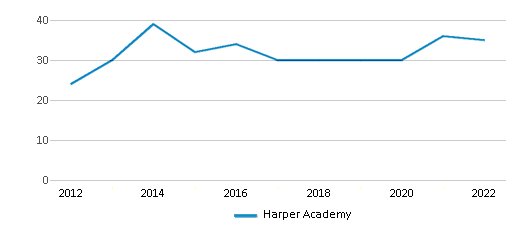
Gender %
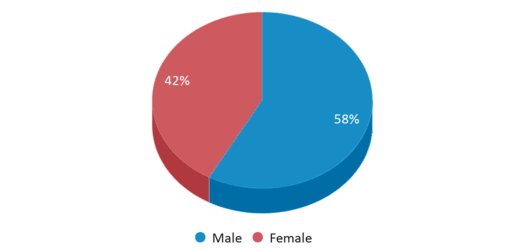
Total Classroom Teachers
1 teacher
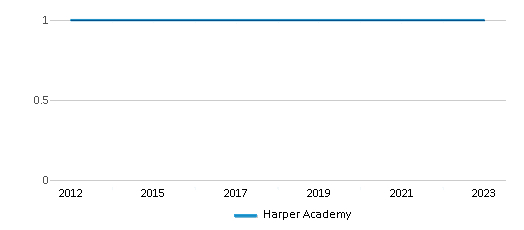
Students by Grade
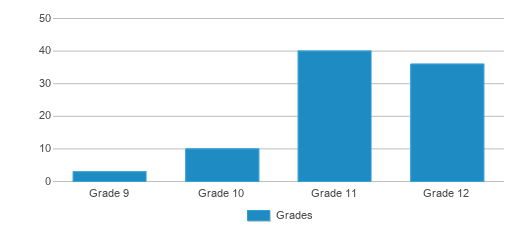
State Accredited Program
No
Personalized Content
No
Live Instruction
No
Rolling Enrollment
No
Flexible Class Schedule
No
Accelerated Offerings
No
Classes for Credit/Part Time Options
No
Dedicated College Counselor
No
Tutoring/Mentoring
No
Community Clubs/Activities Offered
No
School Rankings
The diversity score of Harper Academy is 0.00, which is less than the diversity score at state average of 0.56. The school's diversity has stayed relatively flat over five school years.
Math Test Scores (% Proficient)
(20-21)≤20%
36%
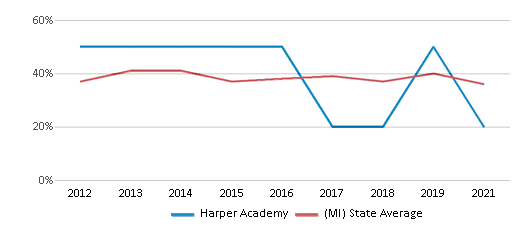
Reading/Language Arts Test Scores (% Proficient)
(20-21)≤20%
48%
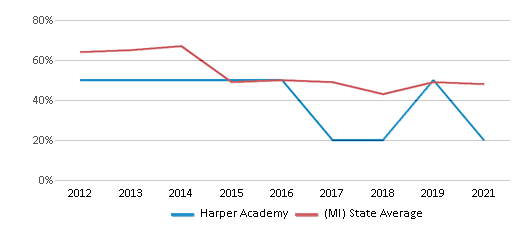
Student : Teacher Ratio
n/a
17:1
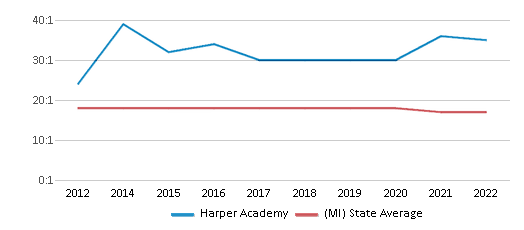
American Indian
n/a
1%
Asian
n/a
4%
Hispanic
n/a
9%
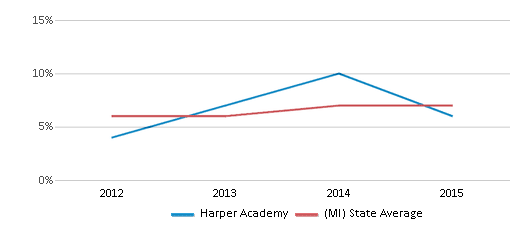
Black
100%
18%
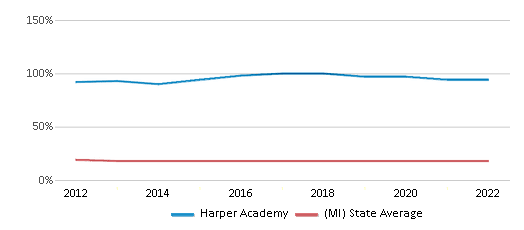
White
n/a
63%
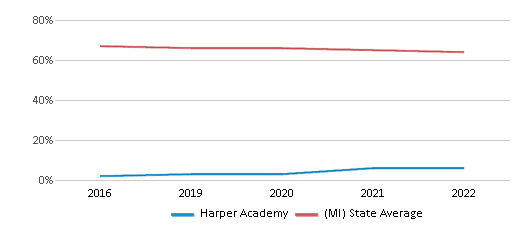
Hawaiian
n/a
n/a
Two or more races
n/a
5%
All Ethnic Groups
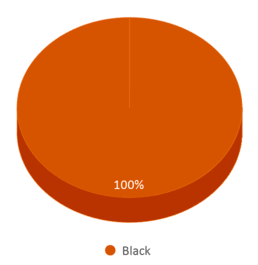
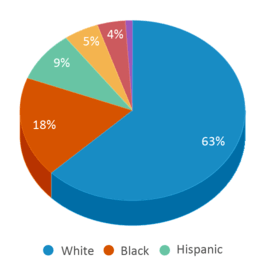
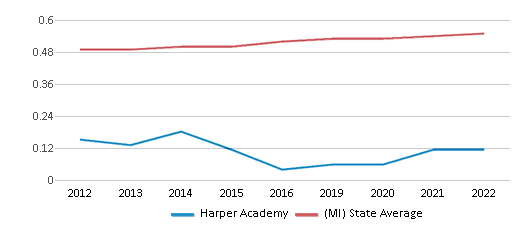
Graduation Rate
≥90%
81%
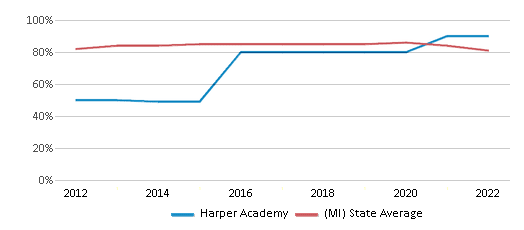
Participates in the National School Lunch Program (NSLP)
Yes
Eligible for Free Lunch
84%
50%
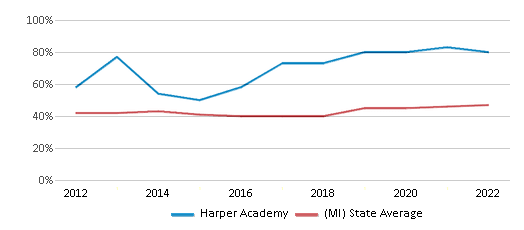
Eligible for Reduced Lunch
2%
4%
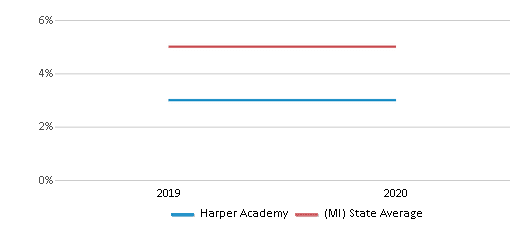
School Statewide Testing
School District Name
Source: National Center for Education Statistics (NCES), MI Dept. of Education
Profile last updated: 02/09/2025
Frequently Asked Questions
What percent of students have achieved state testing proficiency in math and reading?
≤20% of students have achieved math proficiency (compared to the 36% MI state average), while ≤20% of students have achieved reading proficiency (compared to the 48% MI state average).
What is the graduation rate of Harper Academy?
The graduation rate of Harper Academy is 90%, which is higher than the Michigan state average of 81%.
How many students attend Harper Academy?
89 students attend Harper Academy.
What is the racial composition of the student body?
100% of Harper Academy students are Black.
What grades does Harper Academy offer ?
Harper Academy offers enrollment in grades 7-12 (offers virtual instruction).
What school district is Harper Academy part of?
Harper Academy is part of Harper Woods The School District Of The City Of.
School Reviews
Review Harper Academy. Reviews should be a few sentences in length. Please include any comments on:
- Quality of academic programs, teachers, and facilities
- Availability of music, art, sports and other extracurricular activities
Recent Articles

What Is A Charter School?
Explore the world of charter schools in this comprehensive guide. Learn about their history, how they operate, and the pros and cons of this educational innovation. Discover key facts about charter schools, including admission policies, demographics, and funding, as well as what to look for when considering a charter school for your child.

10 Reasons Why High School Sports Benefit Students
Discover the 10 compelling reasons why high school sports are beneficial for students. This comprehensive article explores how athletics enhance academic performance, foster personal growth, and develop crucial life skills. From improved fitness and time management to leadership development and community representation, learn why participating in high school sports can be a game-changer for students' overall success and well-being.

February 05, 2025
Understanding the U.S. Department of Education: Structure, Impact, and EvolutionWe explore how the Department of Education shapes American education, from its cabinet-level leadership to its impact on millions of students, written for general audiences seeking clarity on this vital institution.









